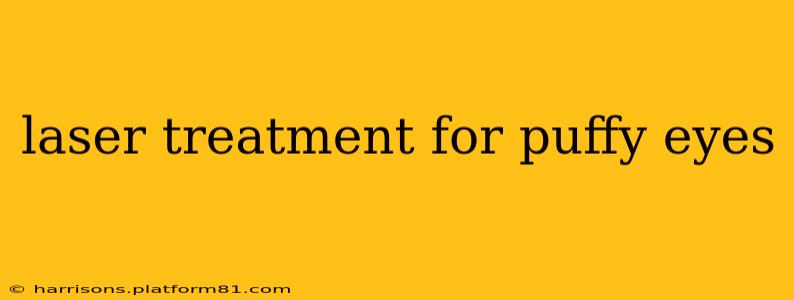Puffy eyes can be a frustrating cosmetic concern, impacting self-confidence and overall appearance. While many factors contribute to under-eye puffiness, from genetics to lack of sleep, laser treatments offer a promising solution for many individuals. This comprehensive guide explores the effectiveness, types, benefits, risks, and considerations of laser treatments for puffy eyes.
What Causes Puffy Eyes?
Before delving into treatments, understanding the underlying causes of puffy eyes is crucial. Several factors can contribute:
- Fluid retention: Excess fluid accumulating under the eyes is a common culprit, often worsened by allergies, sodium intake, or lack of sleep.
- Aging: As we age, the skin loses elasticity and collagen, leading to sagging and the appearance of puffiness.
- Genetics: Some individuals are genetically predisposed to having puffiness under their eyes.
- Allergies: Allergic reactions can cause inflammation and swelling around the eyes.
- Lack of sleep: Insufficient rest can lead to fluid retention and a puffy appearance.
- Sun exposure: UV damage accelerates skin aging, contributing to sagging and puffiness.
What Types of Laser Treatments Address Puffy Eyes?
Several laser technologies can effectively target different aspects of under-eye puffiness:
-
CO2 Laser Resurfacing: This ablative laser removes layers of skin, stimulating collagen production and tightening the skin. It’s highly effective for addressing wrinkles and sagging skin, indirectly reducing the appearance of puffiness. However, it involves a longer recovery period.
-
Fractional Laser Resurfacing: A less aggressive option than CO2 resurfacing, fractional lasers target small areas of skin, minimizing downtime and side effects. It stimulates collagen regeneration, improving skin texture and reducing the appearance of puffiness.
-
Erbium:YAG Laser Resurfacing: Similar to CO2 lasers but gentler, Erbium:YAG lasers cause less damage to surrounding tissue, leading to faster healing times. This is a popular choice for treating fine lines and wrinkles, contributing to a reduction in puffy eyes.
-
Non-ablative Lasers: These lasers don't remove skin but stimulate collagen production from beneath the surface. They offer minimal downtime and are often used for less severe puffiness. Examples include IPL (Intense Pulsed Light) and Nd:YAG lasers.
Does Laser Treatment Permanently Remove Puffy Eyes?
While laser treatments can significantly improve the appearance of puffy eyes, they don't offer a permanent solution for everyone. The results vary depending on the individual's age, skin type, the underlying cause of puffiness, and the type of laser used. Many patients see improvements lasting several years, but maintenance treatments may be necessary to sustain the results.
What are the Benefits of Laser Treatment for Puffy Eyes?
- Improved skin texture and tone: Lasers stimulate collagen and elastin production, leading to smoother, tighter skin around the eyes.
- Reduced wrinkles and fine lines: The skin tightening effect helps minimize the appearance of wrinkles, indirectly reducing puffiness.
- Minimally invasive: Compared to surgical procedures, laser treatments are less invasive and require less downtime.
- Relatively quick procedure: Laser treatments are typically completed within an hour or less.
- Improved self-confidence: A reduction in puffiness can significantly boost self-esteem.
What are the Risks and Side Effects of Laser Treatment for Puffy Eyes?
- Swelling and redness: These are common side effects, usually resolving within a few days.
- Bruising: Minor bruising can occur, but it typically fades within a week.
- Infection: While rare, infection is a possibility and requires prompt medical attention.
- Hypopigmentation or hyperpigmentation: Changes in skin color can occur, though usually temporary.
- Scarring: This is a rare complication but can occur with improper technique or in individuals prone to scarring.
How Much Does Laser Treatment for Puffy Eyes Cost?
The cost of laser treatment varies significantly depending on the type of laser used, the number of sessions required, the geographic location, and the practitioner's fees. It's best to consult with a qualified dermatologist or plastic surgeon for a personalized cost estimate.
Is Laser Treatment for Puffy Eyes Right for Me?
Laser treatment might be a good option if you're bothered by under-eye puffiness caused by aging, sun damage, or poor skin quality. However, it's essential to consult with a qualified dermatologist or plastic surgeon for a thorough evaluation. They can determine if laser treatment is appropriate for your individual needs and discuss alternative treatment options if necessary. A comprehensive consultation will help you understand the potential benefits and risks, ensuring you make an informed decision. Remember that lifestyle changes, such as getting enough sleep, managing allergies, and reducing sodium intake, can also play a significant role in minimizing puffiness.
